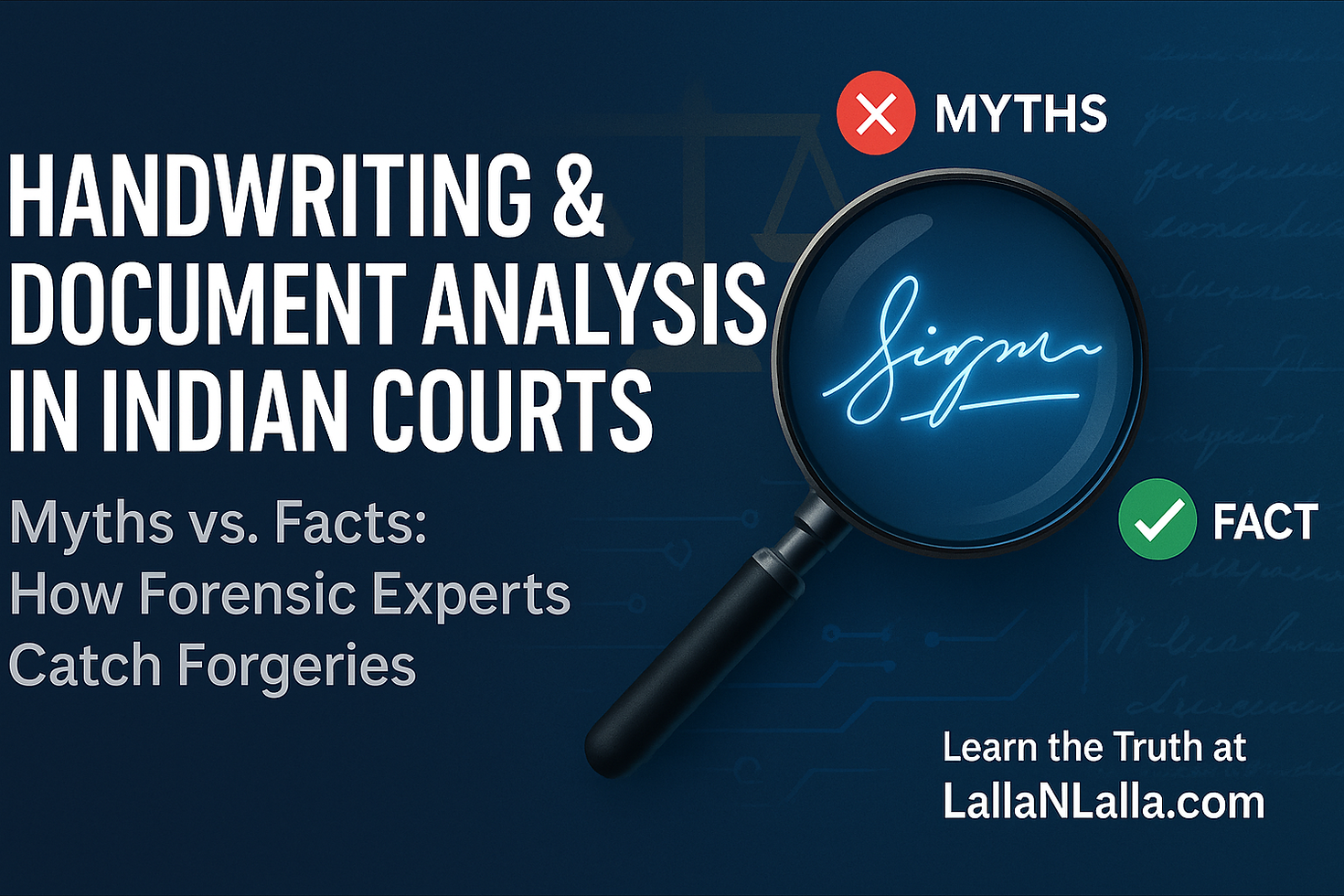
Handwriting and Document Analysis in India: How Forensic Experts Detect Forgeries and Famous Cases That Changed History
- Advocate Anil Lalla
- Aug 28
- 3 min read
Document forgery cases flood Indian courts—property disputes, contested wills,
financial fraud, and corporate document tampering. Advanced forensic handwriting
analysis has become the decisive factor in many high-stakes cases, combining
traditional examination techniques with cutting-edge technology to expose even
sophisticated forgeries.
Myth 1 Debunked :
Myth: Modern technology has made handwriting analysis obsolete.
Reality: Handwriting examination has evolved with technology, not been replaced by it.
Modern forensic labs use high-resolution microscopes, spectral analysis for ink dating,
and digital comparison software. The Forensic Information System for Handwriting
(FISH) now digitizes and stores questioned documents for rapid comparison. Indian
courts increasingly rely on this scientific evidence under Section 45 of the Indian
Evidence Act.
Myth 2 Debunked:
Myth: Only obvious forgeries can be detected.
Reality: Forensic experts analyze minute characteristics invisible to the naked eye—pen
lift patterns, pressure variations, stroke direction, and tremor patterns. Even when
forgers copy writing slowly and carefully, microscopic inconsistencies reveal the
deception. Modern tools can detect ink layering, paper aging, and indentation patterns
that expose sophisticated document fraud.
Myth 3 Debunked:
Myth: Handwriting experts can identify any anonymous writer.
Reality: Successful identification requires adequate comparison samples and sufficient
handwriting characteristics. Experts provide probability assessments based on scientific
analysis, not absolute identification. Indian courts accept this expert testimony cautiously, requiring corroboration with other evidence for convictions.
Famous Indian Cases Where Document Examination Changed
Outcomes:
1. Forgery Before Court: S. Thangavel Case (2024)
Supreme Court clarified Section 195 CrPC requirements when the respondents used
forged sale agreements in civil court. The case established that pre-court forgery doesn't
require court permission for prosecution, overturning the Madras High Court's decision.
2. Property Dispute Document Forgery Cases
Multiple high court cases show document examiners exposing forged property deeds,
with forensic analysis revealing differences in ink composition, paper aging, and
handwriting characteristics that saved legitimate property owners millions.
3. Financial Fraud Detection
Cases involving forged bank documents, where forensic analysis of signatures and
handwriting patterns helped recover wrongfully obtained loans worth crores by proving
systematic document manipulation.
How Forensic Experts Detect Forgeries:
Technical Methods:
• Microscopic examination of pen pressure and stroke patterns
• Ink analysis using spectrophotometry and chromatography
• Paper analysis for age, composition, and manufacturing marks
• Digital enhancement and comparison software
• Indentation analysis from underlying writing
Scientific Principles:
• Individual handwriting characteristics (class and individual features)
• Natural variation vs. deliberate alteration patterns
• Tremor analysis and pen lift patterns
• Speed and fluency indicators in genuine vs. copied writing
Legal Framework and Admissibility:
Under Section 45 of the Indian Evidence Act, forensic handwriting experts can provide
court testimony. Their reports must demonstrate:
• Scientific methodology and peer-reviewed techniques
• Proper chain of custody for examined documents
• Clear comparison between questioned and known samples
• Limitations and confidence levels in conclusions.
LallaNLalla.com's Document Examination Services:
Our forensic team combines traditional document examination with modern technology:
• ISO-certified handwriting analysis laboratory
• Court-admissible expert reports and testimony
• Advanced digital analysis tools and databases
• Collaboration with international forensic experts
• Comprehensive case documentation and evidence preservation.
Conclusion:
Document forgery detection has evolved into a sophisticated science that regularly
exposes million-rupee frauds and protects legitimate document holders. With proper
forensic analysis, even the most careful forgers leave detectable evidence. For cases
involving questioned documents, expert analysis isn't optional—it's essential.
Contact LallaNLalla.com for professional document examination services and expert
forensic testimony.
(caution : These articles cannot and should not be considered as a replacement of a professional legal advice as there are many intricacies that may not have mentioned here).





Comments